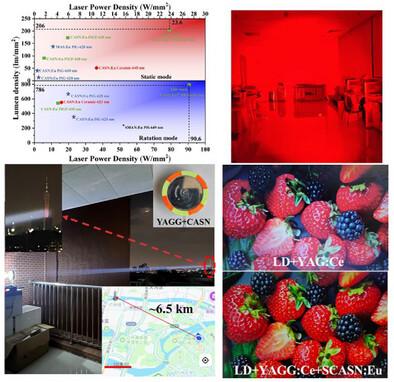High-Efficiency Red-Emitting Phosphor-In-Glass Films for Laser-Driven Lighting and Display
IF 10
1区 物理与天体物理
Q1 OPTICS
引用次数: 0
Abstract
Laser-driven phosphor-converted lighting and display technologies offer exceptional energy efficiency and superior performance. However, the development of high-quality white light sources with both excellent color rendering and high brightness remains a significant challenge due to the scarcity of red-emitting color converters that maintain high efficiency and stability under high laser powder densities. In this study, (Sr, Ca)AlSiN3: Eu2+ (SCASN:Eu) phosphor-in-glass films (PiGFs), emitting from 610 to 680 nm, are fabricated on Al2O3 ceramic substrates with minimal interfacial reactions. All PiGFs exhibited excellent densification and maintained high IQE, losses in IQE remaining below 10 % relative to the original phosphor. Notably, the PiGF with an emission peak at 653 nm achieved a lumen density of 206 lm mm−2 @ 23.6 W mm−2 due to its high thermal conductivity (22 W m−1 K−1) and low IQE loss. Under rotating excitation, it reached a record 786 lm mm−2 @ 90.6 W mm−2. Furthermore, a spatially separated YAGG:Ce-CASN:Eu “phosphor wheel” in reflective mode produced a luminous flux of 1125 lm @ 23.6 W mm−2, a correlated color temperature (CCT) of 6653 K, a color rendering index (CRI) of 86, and CIE coordinates (0.308, 0.338), enabling long-distance illumination and projection display. This work offers a promising strategy for developing high-efficiency color converters for advanced laser-based lighting and display applications.

用于激光驱动照明和显示的高效红色发光磷光玻璃薄膜
激光驱动的磷光转换照明和显示技术提供了卓越的能源效率和卓越的性能。然而,由于缺乏在高激光粉末密度下保持高效率和稳定性的红发色转换器,因此开发具有优异显色性和高亮度的高质量白光光源仍然是一个重大挑战。在本研究中,(Sr, Ca)AlSiN3: Eu2+ (SCASN:Eu)玻璃中磷薄膜(PiGFs)在Al2O3陶瓷衬底上以最小的界面反应制备,发光波长为610 ~ 680 nm。所有pigf都表现出良好的致密性,并保持较高的IQE, IQE的损失相对于原始荧光粉保持在10%以下。值得注意的是,由于其高导热系数(22 W m−1 K−1)和低IQE损耗,发射峰为653nm的PiGF的流明密度为206lm mm−2 @ 23.6 W mm−2。在旋转激励下,它达到了创纪录的786 lm mm−2 @ 90.6 W mm−2。此外,空间分离的YAGG:Ce-CASN:Eu“荧光粉轮”在反射模式下产生的光通量为1125 lm @ 23.6 W mm−2,相关色温(CCT)为6653 K,显色指数(CRI)为86,CIE坐标(0.308,0.338),可实现远距离照明和投影显示。这项工作为开发用于先进激光照明和显示应用的高效颜色转换器提供了一个有前途的策略。
本文章由计算机程序翻译,如有差异,请以英文原文为准。
求助全文
约1分钟内获得全文
求助全文
来源期刊
CiteScore
14.20
自引率
5.50%
发文量
314
审稿时长
2 months
期刊介绍:
Laser & Photonics Reviews is a reputable journal that publishes high-quality Reviews, original Research Articles, and Perspectives in the field of photonics and optics. It covers both theoretical and experimental aspects, including recent groundbreaking research, specific advancements, and innovative applications.
As evidence of its impact and recognition, Laser & Photonics Reviews boasts a remarkable 2022 Impact Factor of 11.0, according to the Journal Citation Reports from Clarivate Analytics (2023). Moreover, it holds impressive rankings in the InCites Journal Citation Reports: in 2021, it was ranked 6th out of 101 in the field of Optics, 15th out of 161 in Applied Physics, and 12th out of 69 in Condensed Matter Physics.
The journal uses the ISSN numbers 1863-8880 for print and 1863-8899 for online publications.

 求助内容:
求助内容: 应助结果提醒方式:
应助结果提醒方式:


